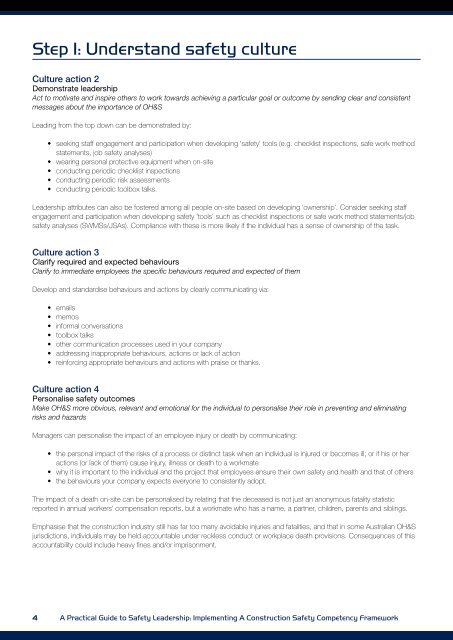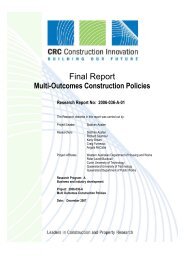A Practical Guide to Safety Leadership Book (PDF 5MB) - QUT ePrints
A Practical Guide to Safety Leadership Book (PDF 5MB) - QUT ePrints
A Practical Guide to Safety Leadership Book (PDF 5MB) - QUT ePrints
You also want an ePaper? Increase the reach of your titles
YUMPU automatically turns print PDFs into web optimized ePapers that Google loves.
Step 1: Understand safety culture<br />
Culture action 2<br />
Demonstrate leadership<br />
Act <strong>to</strong> motivate and inspire others <strong>to</strong> work <strong>to</strong>wards achieving a particular goal or outcome by sending clear and consistent<br />
messages about the importance of OH&S<br />
Leading from the <strong>to</strong>p down can be demonstrated by:<br />
• seeking staff engagement and participation when developing ‘safety’ <strong>to</strong>ols (e.g. checklist inspections, safe work method<br />
statements, job safety analyses)<br />
• wearing personal protective equipment when on-site<br />
• conducting periodic checklist inspections<br />
• conducting periodic risk assessments<br />
• conducting periodic <strong>to</strong>olbox talks.<br />
<strong>Leadership</strong> attributes can also be fostered among all people on-site based on developing ‘ownership’. Consider seeking staff<br />
engagement and participation when developing safety ‘<strong>to</strong>ols’ such as checklist inspections or safe work method statements/job<br />
safety analyses (SWMSs/JSAs). Compliance with these is more likely if the individual has a sense of ownership of the task.<br />
Culture action 3<br />
Clarify required and expected behaviours<br />
Clarify <strong>to</strong> immediate employees the specific behaviours required and expected of them<br />
Develop and standardise behaviours and actions by clearly communicating via:<br />
• emails<br />
• memos<br />
• informal conversations<br />
• <strong>to</strong>olbox talks<br />
• other communication processes used in your company<br />
• addressing inappropriate behaviours, actions or lack of action<br />
• reinforcing appropriate behaviours and actions with praise or thanks.<br />
Culture action 4<br />
Personalise safety outcomes<br />
Make OH&S more obvious, relevant and emotional for the individual <strong>to</strong> personalise their role in preventing and eliminating<br />
risks and hazards<br />
Managers can personalise the impact of an employee injury or death by communicating:<br />
• the personal impact of the risks of a process or distinct task when an individual is injured or becomes ill; or if his or her<br />
actions (or lack of them) cause injury, illness or death <strong>to</strong> a workmate<br />
• why it is important <strong>to</strong> the individual and the project that employees ensure their own safety and health and that of others<br />
• the behaviours your company expects everyone <strong>to</strong> consistently adopt.<br />
The impact of a death on-site can be personalised by relating that the deceased is not just an anonymous fatality statistic<br />
reported in annual workers’ compensation reports, but a workmate who has a name, a partner, children, parents and siblings.<br />
Emphasise that the construction industry still has far <strong>to</strong>o many avoidable injuries and fatalities, and that in some Australian OH&S<br />
jurisdictions, individuals may be held accountable under reckless conduct or workplace death provisions. Consequences of this<br />
accountability could include heavy fines and/or imprisonment.<br />
4 A <strong>Practical</strong> <strong>Guide</strong> <strong>to</strong> <strong>Safety</strong> <strong>Leadership</strong>: Implementing A Construction <strong>Safety</strong> Competency Framework

















